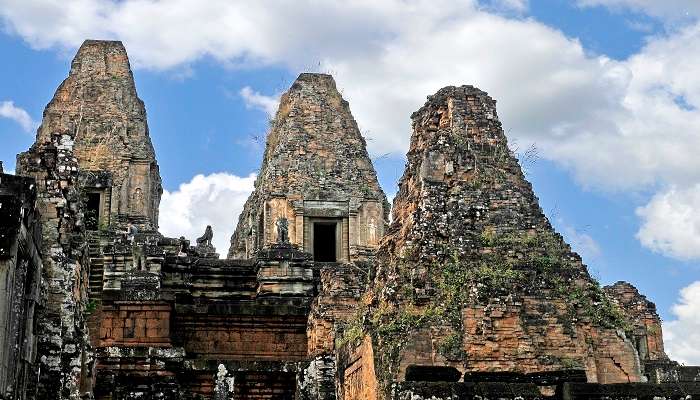Step Into A Journey Of Splendour At Pre Rup Temple
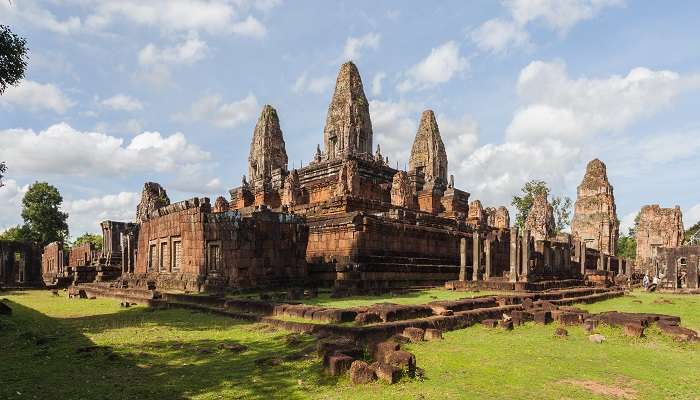
Cambodia is an ancient country covered amid time, with legends, fables, and tales in the form of ancient temples and monuments scattered throughout the country. Amongst 4000 temples, Pre Rup requires your time and will justify every second of it. Pre Rup temple calls travellers with its captivating silhouette rising from Angkor’s verdant plains. More than just a place of worship, Pre Rup served as a powerful symbol of King Rajendravarman II’s reign, legitimising his authority and etching his legacy in stone. The grandeur of Khmer architecture and the serenity of the bygone era are well reflected in the beauty of the Pre Rup temple in Cambodia.
About Pre Rup Temple
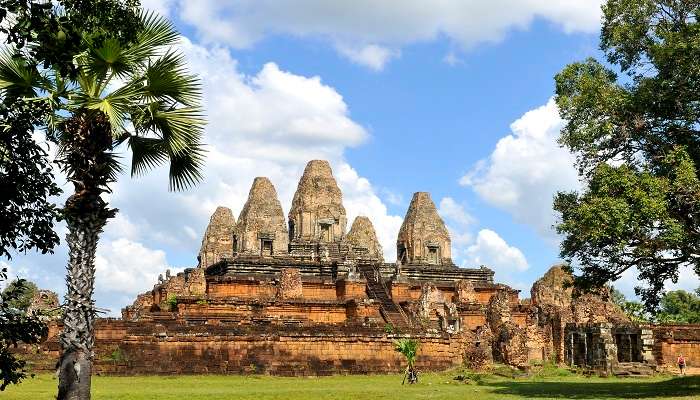
Pre Rup, meaning “turn the body” in Khmer, is a Hindu temple dedicated to Lord Shiva. It was built by King Rajendravarman II. in the latter half of the 10th century and served as a state temple. Construction was done using a combination of laterite, brick, and sandstone. The temple stands as a majestic three-tiered pyramid, reminiscent of Mount Meru, the abode of Hindu gods.
While the modern name, “Pre Rup,” suggests a connection to cremation practices, possibly due to the laterite’s rusty-red hue, the temple’s original purpose remains covered in some mystery. To date, archaeologists and historians continue to debate its purpose, though most agree it served as a religious complex of significant importance.
Must Read: Trekking In Siem Reap
Pre Rup Temple History

The construction and the mere existence of the Pre Rup temple in Cambodia is evidence of Angkor’s history. Following a period of political turmoil the Khmer empire started to pace up. King Rajendravarman II, seeking to establish his reign’s legitimacy, chose this site, which was a Shivaite ashram. Several theories exist regarding the temple’s construction, placement, and history. Some scholars, like Philippe Stern, propose that Pre Rup might have been the centrepiece of a new capital city envisioned by the king. However, there seems to be little archaeological evidence to support the claim. Nevertheless, the temple strongly symbolises the Khmer dynasty’s revival and devotion to Hinduism.
Following its period of grandeur, Pre Rup was slowly consumed by the expanding jungle. It wasn’t until the 1930s that French archaeologists rediscovered the temple and undertook extensive restoration efforts. The temple’s modern architecture showcases a true transition from earlier construction techniques and styles. The temple’s completion paved the way for other monumental stone buildings.
Architecture Of The Pre Rup Temple
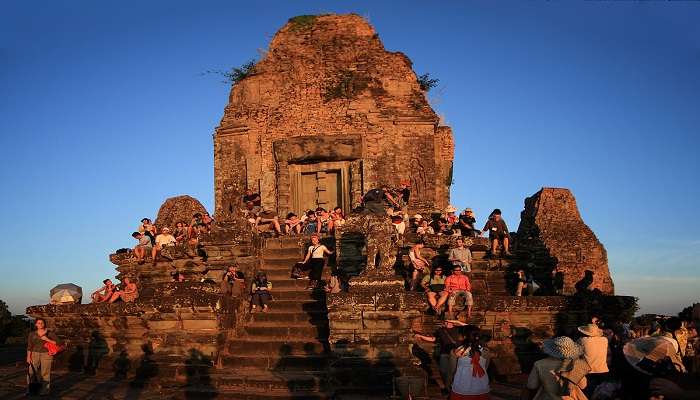
Amidst the talks and mystery surrounding the Pre-Rup temple history, another factor that has caught people’s attention in the past is the temple’s architecture. The temple’s structure and grandeur are constructed on a grand scale.
The most alluring part of the temple’s architecture is the quincunx of towers that stand on top of a three-tiered pyramid. The central sanctuary, surrounded by four smaller towers, represents Mount Meru’s five peaks.
Here’s a further breakdown of the temple’s architecture:
- The temple’s outer enclosure is surrounded by a moat and an outer wall measuring 127×116 metres. The majestic lining of the gopuras with simple architecture stands out at the temple’s entrance.
- The three-tiered Central pyramid stands out among all the structures and elements in the temple. Each level in the pyramid has a series of staircases that lead you to the top. The first two tiers feature galleries of false doors and carved deities among the three.
- At the summit, the central tower is supported by four smaller towers built from brick and sandstone. The detailed lintels and bas-reliefs further enhanced the beauty of the temple’s architecture and made it a little different from its contemporary temples.
- As mentioned in the beginning, the temple used laterite, a reddish-brown clay material. It contributed to the foundation and interior structures of the temple.
- Lintels above doorways showcase exquisite carvings depicting Hindu gods like Indra riding his elephant, Airavata, and Vishnu on his mount, Garuda.
Suggested Read: Museums In Siem Reap
The Best Time To Visit 
The climate in Pre Rup is tropical, meaning it experiences a combination of dry and wet seasons throughout the year. The period from November to April is a dry and peak tourist season. If you get a chance, you must catch a pre-rup sunset.
Months between May and October witness a surge in tourists. Be prepared to experience slight drizzles, but nothing beats the view of the lush greenery surrounding the temple. Compared to peak season, the crowds are significantly smaller during these months, allowing for a peaceful exploration.
How To Get To The Pre Rup Temple?

Located approximately 5 kilometres east of Angkor Wat, Pre Rup is easily accessible from Siem Reap, the primary tourist hub. Tuk-tuk, a local transportation mode, is often preferred by tourists exploring the area because of its availability. It will take around 20 minutes to reach your destination.
If you are travelling in larger groups, taxis are the next best choice. The rates will usually vary depending on the distance and negotiation. The last and often the most adventurous ride is a motorbike or cycle. Several operators offer them on rent, so you can get one and explore the entirety of Siem Reap, including the Pre-Rup temple.
Suggested Read: Shopping In Siem Reap
Entrance Fee

If you are a history buff and architectural enthusiast, this place is for you. The Pre Rup temple doesn’t have a separate entrance fee, which the Angkor Temple pass covers. You must buy it from Siem Reap for a day, three days or a week. It costs $37 a day, $62 for three days and $72 for a week.
Highlights Of The Pre Rup Temple
Pre Rup Temple is an astonishing historical site with several highlights, making it a must-visit destination within the Angkor complex. The following are a few worth noting:
Sunrise And Sunset Views
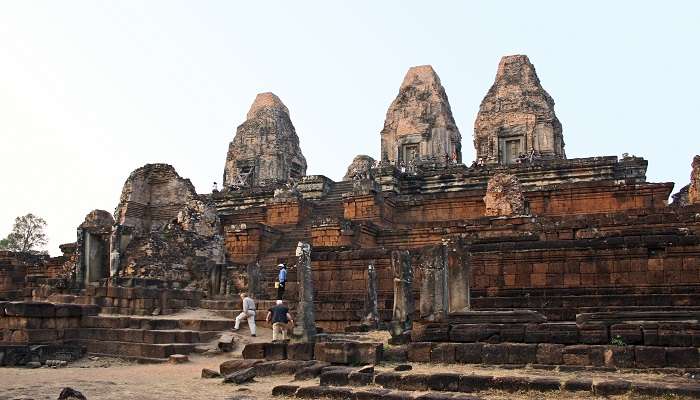
Pre-Rup Temple sunset is a highlight of exploring the temple and the surrounding area. The temple’s elevated location provides spectacular views, especially during sunrise and sunset. During these times, this temple looked gorgeous, which attracted a large number of tourists.
Suggested Read: Temples In Cambodia
Intricate Carvings
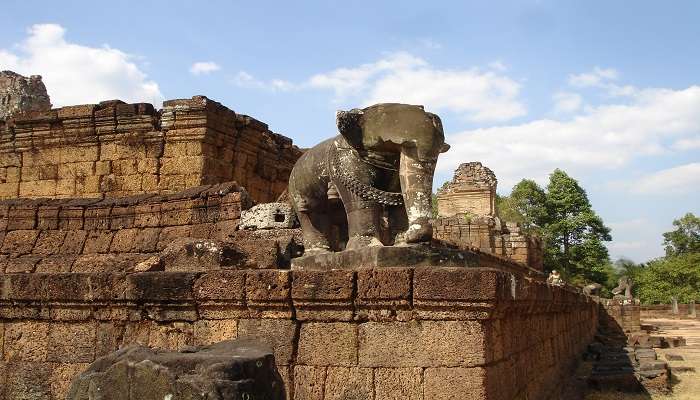
Like most of the amazing temples in Cambodia, the Pre Rup temple is no different in its intricate architecture and detailing. Each relief tells a story from Hindu mythology, offering insights into the religious beliefs of the time. The sculptures are beautifully carved and trace back to the place’s history.
Central Sanctuary
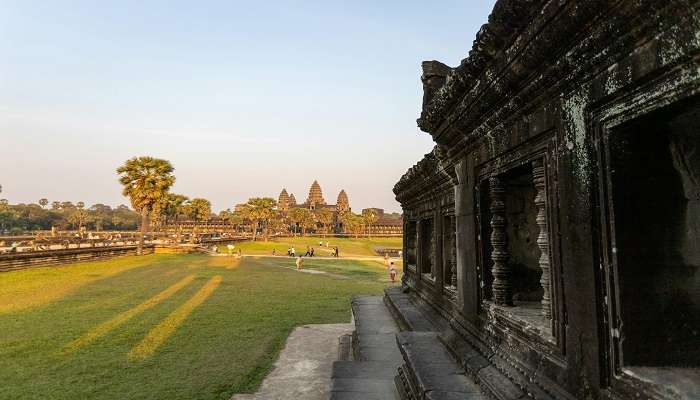
The main highlight of the temple lies in its central sanctuary or inner sanctum, which houses the idol of the deity. Not just that, the surrounding walls and foundations of the inner sanctum also feature intricate detailing on the walls, telling a story of the past. The central sanctuary is one of the main attractions of the Pre Rup Temple.
Suggested Read: Siem Reap Floating Village
Lion Statues
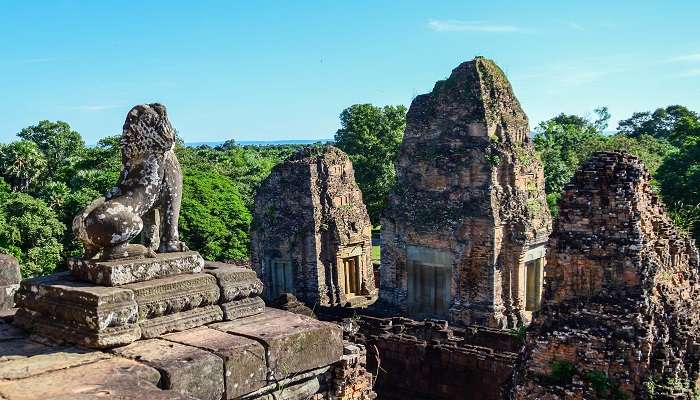
Guardian lion statues surround the staircases leading up the temple tiers. These impressive sculptures symbolise protection and power, adding to the temple’s grandeur and leaving the tourists in awe.
Pre Rup doesn’t receive the same number of tourists as Angkor Wat or Bayon, but if you still decide to visit the temple, you will not regret your decision.
Further Read: Romantic Places In Cambodia
Even though it is in the country of temples, Pre Rup still holds a different charm and will certainly offer something new and fresh from the rest of the temples you will explore on your trip to Cambodia. Its captivating architecture, bathing in symbolism and history, offers a glimpse into a bygone era.
For our editorial codes of conduct and copyright disclaimer, please click here.
Cover Image Credit: Diego Delso for Wikimedia Commons
Frequently Asked Questions About Pre Rup Temples in Cambodia
What is the meaning of 'Pre Rup?'
The name 'Pre Rup' is a modern name and translates to 'turning the body' in Khmer. By visiting this temple, one can attain the divine peace and serenity.
How much time does it take to explore Pre Rup?
Exploring Pre Rup can take anywhere from 30 minutes to an hour. Tourist can also take a tour to the nearby places or the complete enjoyment.
What are the dress code requirements for visiting Pre Rup?
While there's no strict dress code enforced at Pre Rup, respectful attire is recommended. But it is advisable to wear the relevant attire to feel the spirituality.
Can one climb the towers at Pre Rup?
No, one can’t climb the towers at Pre Rup for safety reasons. Take the huge laterite steps to reach the top of the pre rup which is worth the visit.
Is Pre Rup a good option for families with young children?
Pre Rup can be a suitable destination for families with young children. This will be the best picnic spot of vacation destination to spend some time with your loved ones.
People Also Read:
Temples In Tamil Nadu Temples In Vadodra Temples In Jaipur

Unveil the hidden treasures of the globe and turn every travel dream into reality. As a Content Writer, I am passionate enough to craft stories from ancient wonders to modern marvels. My words paint the picture-perfect itinerary for unforgettable experiences. Let my words be your trusted guide to immerse in the diverse culture and discover the beauty of the unknown.
